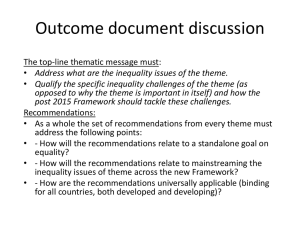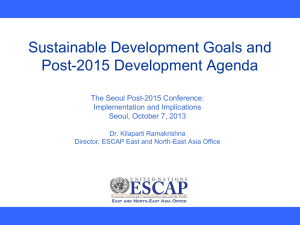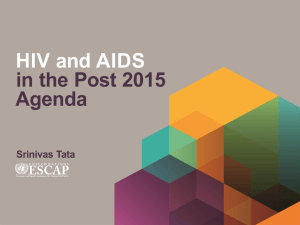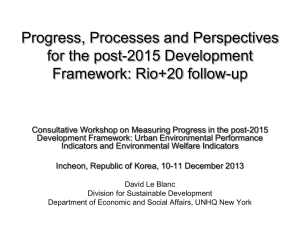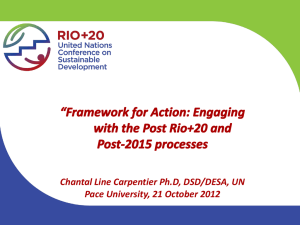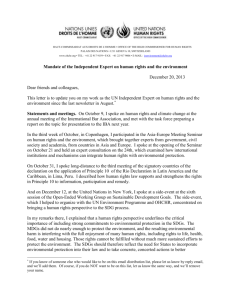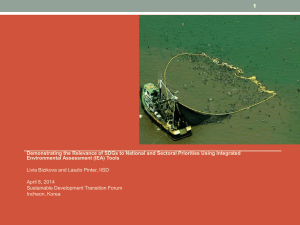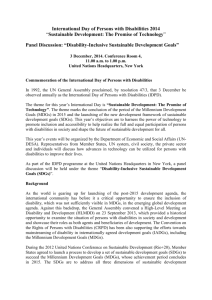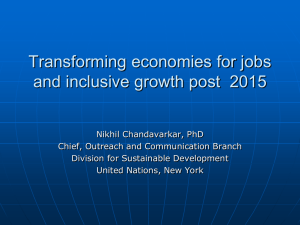ece.cep.2015.L.4.e
advertisement
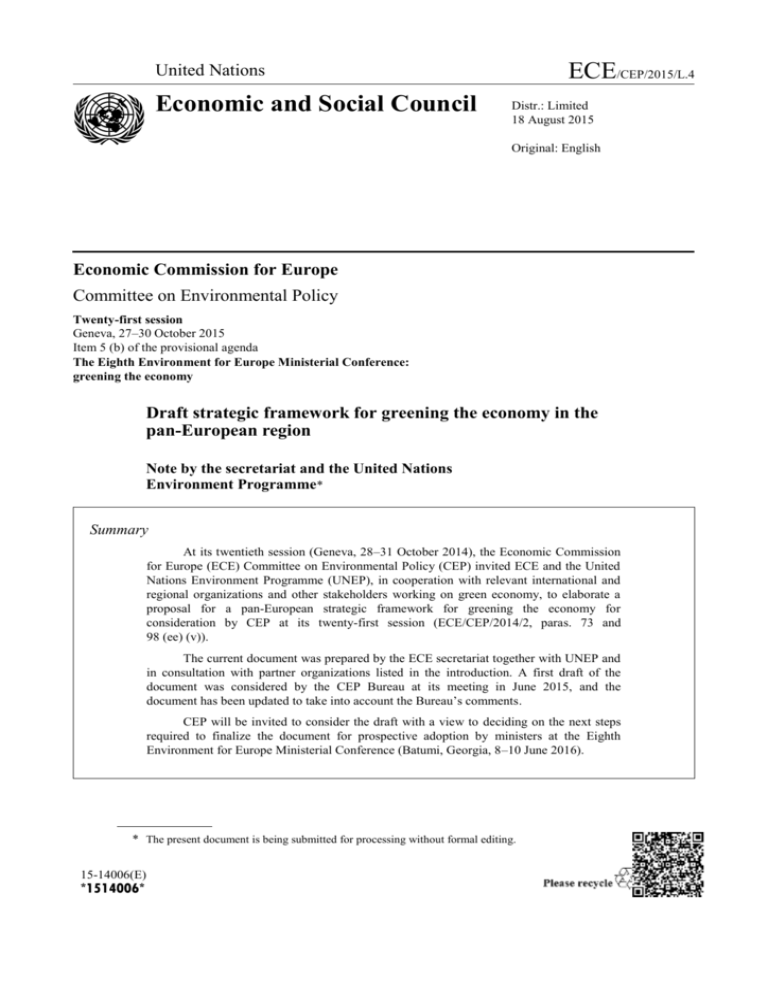
ECE/CEP/2015/L.4 United Nations Economic and Social Council Distr.: Limited 18 August 2015 Original: English Economic Commission for Europe Committee on Environmental Policy Twenty-first session Geneva, 27–30 October 2015 Item 5 (b) of the provisional agenda The Eighth Environment for Europe Ministerial Conference: greening the economy Draft strategic framework for greening the economy in the pan-European region Note by the secretariat and the United Nations Environment Programme* Summary At its twentieth session (Geneva, 28–31 October 2014), the Economic Commission for Europe (ECE) Committee on Environmental Policy (CEP) invited ECE and the United Nations Environment Programme (UNEP), in cooperation with relevant international and regional organizations and other stakeholders working on green economy, to elaborate a proposal for a pan-European strategic framework for greening the economy for consideration by CEP at its twenty-first session (ECE/CEP/2014/2, paras. 73 and 98 (ee) (v)). The current document was prepared by the ECE secretariat together with UNEP and in consultation with partner organizations listed in the introduction. A first draft of the document was considered by the CEP Bureau at its meeting in June 2015, and the document has been updated to take into account the Bureau’s comments. CEP will be invited to consider the draft with a view to deciding on the next steps required to finalize the document for prospective adoption by ministers at the Eighth Environment for Europe Ministerial Conference (Batumi, Georgia, 8–10 June 2016). * The present document is being submitted for processing without formal editing. 15-14006(E) *1514006* ECE/CEP/2015/L.4 Introduction 1. In response to the commitment made by ministers of the United Nations Economic Commission for Europe (ECE) region in Astana in 2011 to take the lead in the transition to a green economy, the ECE Committee on Environmental Policy (CEP) mandated ECE, jointly with the United Nations Environmental Programme (UNEP) and other relevant international organizations and stakeholders working on green economy, to elaborate a proposal for a pan-European strategic framework for greening the economy, for consideration by CEP at its twenty-first session in October 2015 (ECE/CEP/2014/2, paras. 73 and 98 (ee) (v)). 2. CEP requested that the proposed strategic framework should include practical examples, good practices and tools to be used for accelerating the transition to a green economy, while promoting a bottom-up approach. It should also build upon existing knowledge products and platforms, and annex a proposal for a “Green Economy Action” similar to the Astana Water Action.1 3. The present draft proposes initial elements for a strategic framework for greening the economy in the pan-European region, prepared by ECE and UNEP in cooperation with the Organization for Economic Development and Cooperation (OECD) and the European Environment Agency (EEA), and in consultation with organizations participating in the Regional Coordination Mechanism for Europe and Central Asia, in particular the United Nations Development Programme (UNDP) and the International Labour Organization (ILO). Contributions and inputs were collected via a series of brainstorming meetings hosted by ECE and UNEP, and by electronic means, to ensure the proposed framework takes into account relevant ongoing actions. It builds on the analysis and conclusions of the background thematic document on greening the economy in the pan-European region (ECE/CEP/2015/L.2) prepared for the Eighth Environment for Europe (EfE) Ministerial Conference (Batumi, Georgia, 8–10 June 2016). 4. A draft of the document was commented by the CEP Bureau at its meeting in Geneva on 15 and 16 June 2015. The present revised draft is submitted to CEP for consideration and a decision on the next steps required to finalize the document for prospective adoption by ministers at the Batumi EfE Ministerial Conference. 5. A menu of actions under the provisional title of “Batumi Action for the Green Economy”, which complements the document, is presented in the annex. Given its nature as a tool with proposed actions to be taken up voluntarily, it could be considered by CEP for approval with a view to subsequently being endorsed or welcomed by the Conference. I. Draft elements for the strategic framework for greening the economy in the pan-European region Vision [This Strategic Framework envisions the countries of the pan-European region pursuing a development pattern that ensures a healthy economy, social equity and the sustainable use of ecosystems and natural resources, so as to meet the needs of present generations without compromising the ability of future generations to meet their own. Green economy, as an approach to redirect 1 2 See www.unece.org/env/awa. ECE/CEP/2015/L.4 consumption habits, investments and trade in support of green and inclusive prosperity, is a promising avenue towards achieving sustainable development in the region and beyond.]. A. Mandate 6. The Strategic Framework for Greening the Economy in the Pan-European Region2 responds to a decision by ministers at the Eighth EfE Conference in Astana in September 2011 to take the lead in the transition to a green economy, as well as their invitation to ECE to contribute, together with UNEP and relevant international organizations, to the development of the United Nations Conference on Sustainable Development (Rio+20) green economy outcomes.3 B. Aim and scope 7. The aim of the Strategic Framework is to guide the region in making the transition to a green economy by 2030. Such a transition, with adequate support and incentives, will bring investment in innovation for green technology, products and services, foster the transfer of green technology and ensure green behaviours by consumers. It will result in the reduction of environmental risks and address ecological scarcities. It will provide green jobs and minimize the negative consequences of change for the vulnerable groups of society. It will manage any negative economic impacts on enterprises, while retaining incentives for improved economic performance. 8. The Strategic Framework will help countries in the development and implementation of their policies, strategies and plans for greening the economy and achieving sustainable development. To do this, the Framework proposes a vision, objectives and focus areas, and equips countries with a menu of voluntary actions that builds on the policy effort that flowed from Rio+20, as well as on the knowledge base and good practices developed in the region by governmental, intergovernmental and non-governmental actors. It is designed to be flexible enough to be tailored to different national circumstances and entails an operational agenda that steers countries in their efforts to achieve the Rio+20 objectives and the Sustainable Development Goals (SDGs). 9. Creating a regional architecture that facilitates the green transition will require enhanced cooperation among and within countries, as policy measures, including marketbased instruments, deliver better results if implemented in a clear, predictable and coordinated manner. Cooperation also allows building on each other’s knowledge, experience and good practice, and helps to more effectively engage the private sector and civil society, whose role and influence increasingly surpasses national borders. By building on the knowledge base, policies and actions at both regional and national level, and by addressing key constituencies, the Strategic Framework will help to advance such cooperation. 10. The Strategic Framework is expected to serve environment ministers in initiating and sustaining discussions on the green economy in their national Government and, 2 3 The pan-European region under the EfE Process covers the full membership of ECE, i.e., the 56 ECE member States. See the Astana Ministerial Declaration, “Save water, grow green!” (ECE/ASTANA.CONF/2011/2/Add.1), available from www.unece.org/env/efe/Astana/documents.html. 3 ECE/CEP/2015/L.4 ultimately, in creating an interministerial policy process to bring forward such an agenda involving key constituencies, including the public at large and the private sector. 11. The implementation and monitoring of the Strategic Framework at both the regional and national levels could be facilitated by an intergovernmental process. C. Objectives and focus areas 12. Three main objectives will be attained by greening the economy in the pan-European region: • Objective 1. Reduced environmental risks and ecological scarcities. • Objective 2. Enhanced economic progress. • Objective 3. Improved human well-being and social equity. 13. The objectives collectively foster prosperity, through the creation of a healthy economy that is environmentally sustainable and socially inclusive. This can be achieved by incentivizing and promoting investment and trade to support economic progress that is more equitable and decoupled from environmental degradation. It can be further achieved by encouraging consumers to change their habits in order to minimize overconsumption and prioritize green goods and services. The resulting maintenance of natural capital, ecosystems and their services will contribute to prosperity and improving the quality of life, while the reduced environmental stress will decrease human health risks (figure 1). Figure 1 The green economy in action Shared prosperity Reduced environmental risks and ecological scarcities Improved human wellbeing and social equity Enhanced economic progress 14. Focus areas expand on how to achieve each objective with actions proposed to incentivize green investments and trade or green consumption habits in order to advance the green economy transition. 4 ECE/CEP/2015/L.4 Objective 1: Reduced environmental risks and ecological scarcities 15. Natural capital — encompassing natural resource stocks and all living organisms from which ecosystem services are derived, as well as land and the ecosystems themselves — can be depleted if undervalued and mismanaged in economic activities. In a green economy, natural capital is properly valued and managed and thus maintained, ecological infrastructure is enhanced while externalities caused by economic activities and consumption of goods and services are internalized. The focus areas for this objective are: (a) Focus area 1.1: Improve sustainable use of natural capital: green economy allows for economic progress based on the use of the countries’ natural capital (as part of inclusive wealth), provided actions are taken to maintain or sustainably use that capital. It encourages investments into technology, machinery and other solutions that help decouple economic progress from environmental degradation. It further informs and promotes behaviour, knowledge and solutions that help maintain natural capital; (b) Focus area 1.2: Enhance internalization of externalities causing loss or damage to natural capital: green economy considers the cost of economic activities on natural capital (directly and indirectly) and takes actions to ensure that any loss or damage to natural capital is accounted for and internalized by setting the right price signals. Green economy penalizes pollution and in this way encourages investment to make economic activities less polluting. By introducing payments for ecosystem services, it further rewards and compensates those who conserve ecosystems and their services; (c) Focus area 1.3: Enhance ecological infrastructure: green economy values the services of ecosystems that can be recognized due to the functions they provide — for example, water purification, flood control and climate stabilization by forests — as ecological infrastructure. It provides and informs regulations and incentives to restore and enhance the capacity of ecosystems to deliver their infrastructural functions. Objective 2: Rnhanced economic progress 16. Long-term prosperity can be put at risk if consumption, production and trade patterns are not sustainable. Green economy encourages consumers to shift towards sustainable consumption patterns, it incentivizes producers to invest in clean physical capital, products and services, and it promotes fair and green trade in support of sustainable consumption and production. The focus areas for this objective are: (a) Focus area 2.1: Shift consumer behaviours towards sustainable consumption patterns: green economy encourages consumption as a driver to economic markets, but consumption patterns have to be sustainable and equitable. Green economy defines green services and products (labels and standards) and promotes shifting to them. It favours green procurement as well as consumer behaviour resulting in the efficient use of water and energy, and the minimization of waste generation. It progressively increases price rates for the consumption of water, energy and waste utilities, aiming for social equity; (b) Focus area 2.2: Develop clean physical capital for sustainable production patterns: green economy strengthens clean and resource-efficient production processes and infrastructure through green knowledge and technology and introduces green products and services through the application of principles of reuse, repair, upgrade, remanufacture and recycle. It incentivizes a shift to clean technologies while penalizing those who do not make that shift. It encourages closed-loop material cycles and eco-design of products (circular economy approach) as well as resilience and low-carbon design of infrastructure. It promotes synergies between sectors and between economic activities aimed at curbing resource use (nexus approach). It facilitates access to capital for investment in research and 5 ECE/CEP/2015/L.4 innovation to improve clean technologies, products and services and encourages clean technology transfer; (c) Focus area 2.3: Promote green and fair trade: green economy ensures that traded products respect the requirements of green and fair trade, which also entails support for market transparency and development, and the simplification of regulations to facilitate access of locally produced green goods to markets. It further reduces barriers to trade and investment that can place a brake on the development and diffusion of green technologies, while providing for the effective application of intellectual property rights (such that innovation is stimulated while at the same time technology transfer and access to innovation are secured). Objective 3: Improved human well-being and social equity 17. Human well-being and social equity can be undermined if people cannot find employment, if they lack access to essential services or are unable to meaningfully engage in the decision-making that concerns them. The green economy helps to create decent and green employment, ensures and improves access to healthy living and well-being and encourages public participation and education for sustainable development (ESD). The focus areas for this objective are: (a) Focus area 3.1: Increase green and decent jobs, while developing the necessary human capital: green economy helps to create green and decent jobs and ensures the necessary education and training for the workforce to develop skills needed for those jobs. It incentivizes the creation of incubators for green entrepreneurship. It develops opportunities for new green markets and jobs in these markets. It facilitates access to funds for training and retraining. It incentivizes green apprenticeship programmes for youth; (b) Focus area 3.2: Improve access to services, healthy living and well-being: green economy supports healthy living and well-being, including for low-income and vulnerable groups. It promotes programmes and solutions allowing vulnerable groups to have access to essential services — e.g., water and energy utilities, housing, transport and health services — and to use them in an efficient way. It establishes social protection floors to counterbalance the effects of the transition on vulnerable groups. It prioritizes urban spatial planning to ensure healthy living and well-being; (c) Focus area 3.3: Promote public participation and education for sustainable development: green economy promotes access to information and public participation in decision-making as a prerequisite for meaningful green and sustainable governance. It ensures access to ESD that enables citizens to act responsibly vis-à-vis the environment and other people. 6 ECE/CEP/2015/L.4 Figure 2 The Strategic Framework at a glance Strategic Framework for Greening the Economy in the Pan-European Region Vision for the Green Economy in the Pan-European Region Reduced environmental risks and ecological scarcities D. Actions Improve sustainable use of natural capital Enhance internalization of externalities causing loss or damage to natural capital Enhance ecological infrastructure Enhanced economic progress Shift consumer behaviours towards sustainable consumption patterns Develop clean physical capital for sustainable production patterns Promote green and fair trade Improved human well-being and social equity Increase green and decent jobs, while developing the necessary human capital Improve access to services, healthy living and well-being Promote public participation and education for sustainable development Green Action Menu Knowledge base, policies Economy and good practices at regional/national level Knowledge base, policies and good practices at regional/national level 18. Transitioning to a green economy involves a mix of actions that reinforce a healthy economy and the maintenance of natural capital, ranging from policies targeted at incentivizing the efficient use of natural resources to approaches inclusive of the broader social values of sustainable development. The Strategic Framework identifies these actions based on existing national and regional strategies, plans and policy documents, and structures them in an easy to use format. 19. A list of actions has been developed under each of the green economy focus areas (see annex). The list is intended as a menu of options to inspire national action. It also serves as a tool for environment ministers to engage with different ministries and stakeholders across their national governments, and highlights ways in which key economic 7 ECE/CEP/2015/L.4 sectors (e.g., transport and energy) can adopt a green economy approach. The menu is further expected to be expanded with new actions over time as they are formulated and successfully tested to help the transition to a green economy. Figure 3 Action Menu at a glance Green Economy Action Menu Sectors Agriculture, Economy-Wide Cities Forestry, Fishing, Energy, Mining, Manufacturing, Transport, Water, Waste, Tourism and Housing, Buildings and Construction Legal & regulatory instruments Economic & fiscal instruments Information, educationbased, capacity-building & voluntary instruments Knowledge base, policies and good practices at the regional or national level E. Contributing to implementation of the Sustainable Development Goals 20. The transition to green economy is a driving force for sustainable development, also supporting the achievement of many of the internationally agreed SDGs and targets. The Strategic Framework leverages the substantial body of analysis and policy effort that flowed from the 1992 United Nations Conference on Environment and Development, and entails an operational agenda that can help countries in their efforts to achieve the Rio+20 commitments and the goals included in the 2030 Agenda for Sustainable Development. Showing links between the Framework’s objectives, focus areas and actions on the one hand, and the SDGs and their targets, on the other, provides countries with a clearer picture of possible avenues to advance the green transition while at the same time making progress on the aspects of the 2030 Agenda relevant to their development priorities (see figure 4). 8 ECE/CEP/2015/L.4 Figure 4 Linking objectives and focus areas to the SDGs Enhanced economic progress Improved human well -being and social equity OBJECTIVES Reduced environmental risks and ecological scarcities FOCUS AREAS Improve sustainable use of natural capital Enhance internalization of externalities causing loss or damage to natural capital Enhance ecological infrastructure Shift consumer behaviours towards sustainable consumption patterns Develop clean physical capital for sustainable production patterns Promote green and fair trade SDGs 6 13 14 15 6 12 13 14 15 6 14 15 7 8 12 13 7 8 12 13 2 10 12 17 Increase green and decent jobs, while developing the necessary human capital 4 5 8 10 Improve access to services, healthy living and well-being 1 3 12 Promote public participation and ESD TARGET S 4 10 12 16 9 ECE/CEP/2015/L.4 F. Implementation and review 21. The Strategic Framework proposes a vision, objectives and focus areas for greening the economies in the pan-European region, and possible actions to achieve these by 2030, in line with the goals and targets of the 2030 Agenda for Sustainable Development. 22. It is meant to inspire action and provide state-of-the-art advice for strategies and plans that aim at greening the economy, by building upon existing knowledge, policies and practices at the international, regional and national levels — e.g., the Green Growth Knowledge Platform.4 The actions would be implemented on a voluntary basis by governments, as well as the private sector, civil society and other stakeholders, with support from international organizations. 23. Putting the Strategic Framework into practice entails mainstreaming the green economy approach into regional and national policies. In both cases, the transition to an inclusive green economy should adapt and incorporate nationally developed policies and strategies where possible, so as to avoid contradictions or duplication with other existing efforts. 24. At the national level, key dynamics in implementation include clear leadership and communication, coordination across ministries and multi-stakeholder engagement, as the transition to a green economy entails numerous actions across multiple sectors. Engaging the private sector, civil society and other stakeholders is imperative to ensure ownership, private investment flows, establishment of partnerships and behavioural changes. 25. At the regional level, the strategic framework could anchor national efforts in a set of shared objectives and focus areas, as well as promote coordination in the implementation and monitoring of progress and the provision of technical assistance and capacity-building for countries. 26. The transition to an inclusive green economy also entails monitoring and reviewing progress. Given that countries have already invested in the 2030 Agenda for Sustainable Development process, monitoring progress in greening the economy would draw on the SDGs, targets and indicators. The available knowledge base with data and information common to the region — e.g. available through the shared environmental information system (SEIS)5 — could be used to produce the indicators. 4 5 10 For more details please see www.greengrowthknowledge.org. The link to the SEIS website, which is still under development, will be added at a later stage. ECE/CEP/2015/L.4 Annex Draft Batumi Action for the Green Economy 1. The Strategic Framework for Greening the Economy in the Pan-European Region proposes a vision, objectives and focus areas to achieve the green transition by 2030, in line with the goals and targets of the 2030 Agenda for Sustainable Development. 2. It is complemented by the Batumi Action for the Green Economy, which is intended as a menu of actions for countries to be inspired by and choose from. It also serves as a tool for Environment Ministers to work across their national governments with key ministries and stakeholders, and highlights ways in which key economic sectors can adopt a green economy approach. 3 With an action menu to draw from, built upon existing efforts of countries in the region, countries can be both ambitious and realistic, with the knowledge that many of the actions in the menu have already been tried and tested within the region. 4. Implementing a green economy strategy involves a mix of actions, which draw from framework conditions that reinforce economic progress and maintenance of natural capital, from policies targeted at incentivising the efficient use of natural resources, and approaches centering on the broader social pillar of sustainable development. 5. The green economy actions are clustered according to their scope, i.e. economywide and sectorial. In addition, since cities also play a key role in the green transitions, the framework includes actions that can help making them smarter, more resource efficient and inclusive. Priority sectors for greening the economy in the region include: Agriculture/Forestry/Fishing, Energy/Mining, Manufacturing, Transport, Water, Waste, Tourism, and Housing/Buildings/Construction. 6. At the same time, a green economy approach requires combining actions aimed at implementing the traditional command-and-control regulatory instruments, with actions aimed at introducing new innovative tools including collective public action to change the patterns of production and consumption, and market-based instruments to shift funding towards green investment and clean technology development and improved resource efficiency. The menu lists such actions according to the following types: (a) Legal or regulatory instruments: Include actions to implement commandand-control regulatory instruments, to change the patterns of production and consumption, improve efficiency and promote trade of green products. Examples are green procurement legislation and mandatory standards, technology and efficiency requirements. (b) Economic and fiscal instruments: Include actions that are used to send or adjust price signals in support of a green economy transition. Common examples include environmental taxation, trading permits, subsidy reforms, extended producer responsibility systems, deposit-refund systems and payment for ecosystem services. This type of instruments also includes public expenditure efforts, such as financial support to green investments through soft loans, credit lines, publicly backed guarantees and revolving funds. (c) Information, education-based, capacity building and voluntary instruments - often referred to as “softer” instruments: Include actions aimed at driving behavioural changes, with the goal of making consumers and business pursue green options based on knowledge of benefits and opportunities that can be achieved. They include voluntary certification and labelling schemes as well as awareness raising campaigns, educational and capacity-building programmes knowledge and skills sharing needed to build the human capital for green economy. 11 ECE/CEP/2015/L.4 7. The following table presents a draft list of actions, from which countries can choose based on their green economy priorities and policies. Once finalised, the Batumi Action for the Green Economy will be produced in an electronic format for a user-friendly navigation through the proposed actions. In addition, the table in electronic format could be expanded to include good practices and examples for each action, as available. 8. The entire action menu could be made available for access through the Green Growth Knowledge Platform, subject to a decision by CEP. It is further expected to be expanded with new actions over time as they are formulated and successfully tested by countries for helping the transition to a green economy. 12 Green Economy Action Menu Table 1 Objective 1: Reduced environmental risks and ecological scarcities Focus area 1.1: Improve sustainable use of natural capital Legal or regulatory instruments Economy-wide Economic and fiscal instruments Information, education-based, capacity building and voluntary instruments Establish linkages between investment in the green economy and the benefits it can have for sustainable management of natural capital in teaching, research and innovation in the accreditation standards and curricula of MBA courses (SDGs 14,15) Renounce, as part of any government procurement or related activity, the use of products from species threatened with extinction (which in turn, benefits goods produced sustainably) (SDGs 14,15) Encourage companies’ own engagement for environmental sustainability (e.g. by encouraging responsible investment , or sustainable supply chains and production patterns through the use of labels and standards) (SDGs 13,14,15) Introduce trade regulation on hazardous substances and implement the 'Right-toKnow' (i.e., establishment a Chemical Safety Inspectorate, regulation of information on chemical safety, use of chemicals and their hazards) (SDGs 15) Promote innovative partnerships for conserving wildlife through shared management responsibilities (e.g. investments in community conservancies, public‐private partnerships, sustainable tourism, revenue‐sharing agreements and other areas such as sustainable agriculture) (SDGs 15) Regulate a moratorium on drilling approvals that will ensure the protection of Arctic ecosystems and wildlife (SDGs 13,15) Promote niche and quality products and services of fragile eco-systems through mechanisms such as branding, labelling and standards (e.g. wildlife habitat). This, in turn, promotes markets and economic opportunity for these products and services 13 ECE/CEP/2015/L.4 Enact regulation to facilitate access to Initiate a national ecosystem restoration genetic resources for environmentally sound program, modelled on payments for uses (e.g. the user of genetic resources to set ecosystem services (SDGs 6,14,15) up laboratories or a drug manufacturing facility in the provider country, joint ownership of intellectual property rights, shared royalties) (SDGs 14,15) Economic and fiscal instruments Information, education-based, capacity building and voluntary instruments (SDGs 15) Identify major impacts of trade on biodiversity and adopt legal or regulatory measures to significantly reduce that impact (SDGs 14,15) Promote the economic and other values of biodiversity conservation as a way to draw attention to the benefits of conservation (SDGs 15) Introduce regulations on Strategic Environmental Assessment, including enforcement mechanisms (SDGs 6,14,15) Identify key vulnerabilities to climate change and conduct assessments on how these may impact economic/investment opportunities over the long term. (A natural follow up is to take action to mitigate economic risks posed by climate change) (SDGs 13) Regulate biological resources important for the conservation of biological diversity whether within or outside protected areas (SDGs 14,15) Promote trans boundary aspects of ecosystem services through joint bodies for transboundary cooperation and regional economic integration organizations (e.g. river and lake transboundary commissions) (SDGs 14,15) Ensure environmental permitting is based on detailed pollution limits for numerous individual substances (SDGs 6,13,14,15) Cities Incorporate green infrastructure options into Harvest, store and re-use rainwater in lowcity planning carbon systems and incorporate such systems into all strategies for GI to ensure that ecosystem services can be maximised and maintained – thus increasing resilience to climate change. (such as urban cooling) (SDGs 6) Sectoral: Agriculture Introduce regulations to limit trade of farm products produced against the codes and standards of Good Agricultural Practices (GAP) (SDGs 6,15) Introduce tax breaks for farm machinery, technology and equipment versatile enough to adjust production decisions to account for variable climatic conditions and promote Inform about the economic and environmental benefits of prevention and control measures for land owners and land managers to manage invasive species using integrated pest management (IPM) (which ECE/CEP/2015/L.4 14 Legal or regulatory instruments Legal or regulatory instruments Economic and fiscal instruments sustainable agriculture practices (SDGs 15) Sectoral: Fisheries Information, education-based, capacity building and voluntary instruments can include pulling, cutting, targeted pesticide use, biological controls and native species reintroduction). (SDGs 15) Introduce regulations and enforcement mechanism to hinder farming on marginal land, while promoting, enabling opportunities for alternative economic opportunities for these lands, including conservation activities (SDGs 15) Promote use of sand fences, shelter belts, woodlots and windbreaks to minimize desertification (resulting in higher agricultural production) (SDGs 15) Introduce regulation to protect fertile agricultural soils and to restore valuable rivers and wetlands so that they can help alleviate potential floods, and promote sustainable economic opportunities for the long-term. (i.e. food production) (SDGs 15) Promote sustainable soil management practices (such as enrichment and hyperfertilizing of soil through planting) (SDGs 15) Adopt the FAO Code of Conduct for Responsible Fisheries for effective conservation, management and development of living aquatic resources, with due respect for ecosystems and biodiversity (SDGs 14) Regulate coastal development to prevent destruction of ecologically sensitive areas and critical habitat for valuable fish species, while promoting economic development opportunities that focus on sustainable management of resources (SDGs 14) Sectoral: Forestry 15 Ensure timber imports are derived from sustainable sources, combating illegal logging and adopting measures to prevent, Encourage reforestation and tree regeneration in relation to forestry sector development and promote improvement to ECE/CEP/2015/L.4 Develop long-term management and recovery plans to help rebuild collapsed fish stocks and maintain others at safe biological levels (SDGs 14) Economic and fiscal instruments minimise and/or mitigate against deforestation (SDGs 15) Information, education-based, capacity building and voluntary instruments information on forest stocks, flows and costbenefit distribution (SDGs 13,15) Introduce forest certification to ensure forestry products meet sustainability standards (SDGs 15) Sectoral: Housing Adopt green housing policies and integrate them into sustainable urban and territorial development policies (SDGs 13) Introduce regulation for reducing airborne Sectoral: Manufacturing pollution and exposure to toxic chemicals in line with the Thematic Strategy on Air Quality and REACH (SDGs 15) Sectoral: Tourism Endorse the WTO’s “Global Code of Ethics in Tourism” (SDGs 15) Introduce and enforce Environmental Impact Assessment for activities in mountainous regions, particularly in fragile high elevation alpine ecosystems (e.g. at ski areas and other large resorts, and especially with respect to alpine lifts, trams and roadways) (SDGs 15) Endorse careful planning of controlled development in mountainous regions, particularly in fragile high elevation alpine ecosystems (e.g. at ski areas and other large resorts, and especially with respect to alpine lifts, trams and roadways) (SDGs 15) Sectoral: Water Enhance monitoring and enforcement efforts Introduce tax breaks for development of and introduce regulations governing water non-traditional sources of water (e.g. eco-systems to prevent accidental pollution desalination, purification) (SDGs 6) (SDGs 6,15) Plan wastewater management activities Introduce tax breaks for development of Develop and promote safe water reuse activities for commercial/industrial users (SDGs 6) ECE/CEP/2015/L.4 16 Legal or regulatory instruments Legal or regulatory instruments Economic and fiscal instruments against future scenarios, not current situations (taking into account increasing population, economic activities, climate change effects) (SDGs 6,13) water-efficient infrastructure and technology (e.g. small-local water supply systems) (SDGs 6) Information, education-based, capacity building and voluntary instruments Introduce and enforce regulations for reducing point source pollution (e.g. in line with existing EU Directives on Urban Waste Water Treatments, Integrated Pollution Prevention and Control, Large Combustion Plants and Waste Incineration) (SDGs 6,13) Integrate water and wastewater planning and management at national and municipal levels (SDGs 6) Significantly reduce point source pollution – through better implementation of existing regional legislation on Urban Waste Water Treatments, Integrated Pollution Prevention and Control, Large Combustion Plants and Waste Incineration (e.g. relevant EU Directives) (SDGs 6) ECE/CEP/2015/L.4 17 Focus area 1.2: Enhanced internalization of externalities causing loss or damage to natural capital Legal or regulatory instruments Economy-wide Mandate for government the internalization of costs and benefits of conserving fragile ecosystems in national wealth accounting, resource allocation, and development plans (SDGs 14,15) Economic and fiscal instruments Remove harmful fossil fuel subsidies (SDGs 12,13,15) Internalize cost of resource depletion, environmental degradation, pollution and illhealth through pollution levies, charges, taxes (e.g. CO2 tax) (SDGs 6,12,13,14,15) Implement penalties for the deliberate release of Genetically Modified Organisms (GMOs) into the environment to ensure the protection of biodiversity (SDGs 12,15) Implement systems for payments of ecosystem services in order to increase the financial resources to protect and restore water-related ecosystems (e.g. taxes or charges on users of environmental services or subsidies and compensation for protection of water-related ecosystems) (SDGs 6,15) Introduce concrete mechanisms to reward and compensate communities for the conservation and provision of ecosystem services (e.g. access and benefit sharing and property rights) (SDGs 14,15) Sectoral: Waste Advance legislation to transfer the financial burden of managing the waste found as marine debris from local government and Information, education-based, capacity building and voluntary instruments ECE/CEP/2015/L.4 18 Table 2 Objective 1: Reduced environmental risks and ecological scarcities Legal or regulatory instruments Economic and fiscal instruments Information, education-based, capacity building and voluntary instruments taxpayers to the producers, thus advancing source-reduction and recycling (Extended Producer Responsibility) (SDGs 12,15) Sectoral: Water Introduce water use levies, for revenues to be used by water authorities to fund the water governance functions and infrastructure required to manage water resources and ecosystems (SDGs 6,12,15) Introduce well-structured pollution fees for depletion based on water use as a means of improving water efficiency (SDGs 6) Set up a water quota management system by preparing industrial water quotas for effective control of surface and groundwater resources, including a system of fines or penalties to address over-use of allocated water resources or illegal abstraction of water. (Revenues generated may partly be used to fund e.g. investments in watersaving, wastewater treatment equipment, or wetland restoration) (SDGs 6) Introduce payment for watershed services to farmers and land managers to adopt practices that improve valuable watershed services (SDGs 6) 19 ECE/CEP/2015/L.4 Implement polluter-pays systems for accidental water pollution and for discharges of waste water (SDGs 6,12,15) Focus area 1.3: Enhance ecological infrastructure Legal or regulatory instruments Economic and fiscal instruments Information, education-based, capacity building and voluntary instruments Economy-wide Strengthen knowledge of ecological infrastructure functions, conditions, and resiliency through increased investments in science, research and technology efforts (SDGs 14,15) Sectoral: Agriculture Sectoral: Water Introduce regulation to protect and to restore valuable wetlands so that they can help alleviate potential floods (SDGs 15) Incorporate principles of ecosystem-based management from the watersheds into the sea (e.g. protecting wetlands to store nutrients and GHG emissions) (SDGs 6) Protect, enhance and buffer waterways both in-channel and along the banks (SDGs 6) Introduce training programmes on the conservation and restoration of water-related ecosystems with functions of ecological infrastructure as part of local and national action programmes (SDGs 6) ECE/CEP/2015/L.4 20 Table 3 Objective 1: Reduced environmental risks and ecological scarcities Table 4 Objective 2: Enhanced economic progress Focus area 2.1: Shift consumer behaviours towards more sustainable consumption patterns Legal or regulatory instruments Economy-wide Pass regulation to favour procurement of sustainable goods and services, including clear criteria for goods and services (SDGs 12) Economic and fiscal instruments Information, education-based, capacity building and voluntary instruments Introduce full-cost recovery pricing for food, Train staff in public purchasing departments energy, and water (SDGs 7) on sustainable public procurement (SDGs 12) Offer tax exemptions for purchase of green goods and services (SDGs 8,12) Launch national campaigns on the benefits of sustainable consumption and production (SDGs 12) Provide information for sustainable products (labels) and promotion of sustainable consumption (e.g. labelling for household appliances) (SDGs 12) Introduce congestion taxes, entering rights based on car emission levels (SDGs 7,13) Sectoral: Cities Provide transportation incentives for bicycles and mopeds (e.g. subsidies, reduced insurance premiums) (SDGs 12) Sectoral: Cities/Transport ation Introduce water-meters to promote efficiency (SDGs 12) Sectoral: Cities/Water Sectoral: Agriculture Energy Sectoral: Housing/Cities Run national campaigns aimed at sustainable food and diets (SDGs 12) Introduce progressive energy fares to discourage overconsumption (SDGs 7,12) Encourage construction of multifamily housing, promote integrated public 21 ECE/CEP/2015/L.4 Sectoral: Introduce regulations to limit trade of farm products produced against the codes and standards of Good Agricultural Practices (GAP) (SDGs 12) Economic and fiscal instruments Information, education-based, capacity building and voluntary instruments transportation in order to, mainly, counteract urban sprawl and save energy (SDGs 7) Promote and provide incentives for purchase/production of green and lowcarbon vehicles (SDGs 7,13) Sectoral: Transportation Introduce car scrappage schemes designed to turn over the car fleet and encourage use of cleaner vehicles (SDGs 7) Introduce progressive waste collection fares (e.g. volumetric landfill taxes, pay-as-you throw policies) (SDGs 12) Sectoral: Waste Promote creative reuse of wastes to stimulate societal awareness of the value of creative reuse of waste-material, and thereby contribute to a greater ecological awareness in society (SDGs 12) Table 5 Objective 2: Enhanced economic progress Focus area 2.2: Develop and promote clean physical capital for more sustainable production patterns Legal or regulatory instruments Economy-wide Implement Resource Efficiency Programs, addressing the sustainable use of raw materials in production of goods (SDGs 12) Carry out integrated assessment of environmental and socio-economic impacts of infrastructural expansion (SDGs 9,12) Economic and fiscal instruments Information, education-based, capacity building and voluntary instruments Use revenues from carbon pricing measures to increase support for research, development, demonstration and precommercial deployment of low-carbon technologies (SDGs 7,9) Adopt voluntarily International Organization for Standardization (ISO) environmental management and product standards, as well as agreements for energy efficiency at the industry level. (SDGs 7,12) Provide public financial tools, instruments and funds to facilitate access to financing and attract co-financing for green projects, particularly early-stage funding (e.g. clean technology fund) (SDGs 8,9) Provide energy efficiency advice for small and medium-size enterprise (SDGs 7,12) ECE/CEP/2015/L.4 22 Legal or regulatory instruments Information, education-based, capacity building and voluntary instruments Economic and fiscal instruments Ensure environmental impact assessments, environmental audits of firms' use of resources (SDGs 12) Support private investment for green growth Promote voluntary patent pools and by establishing a predictable and sound collaborative mechanisms for green policy and regulatory environment that technologies (SDGs 9) includes systematic internalization of the cost of negative externalities, for example by putting a price on carbon, removal of inefficient fossil fuel subsidies, setting congestion charges in cities, or developing financial regulations that recognise and reward environmental and social performance) (SDGs 8,9) Integrate environmental permitting for large industry specifying major pollutant emission limits and on-site monitoring procedures (SDGs 12) Improve coherence of the broad system of Encourage green industrial and professional investment incentives and disincentives (e.g. associations to strengthen green industry by setting long-term goals, removing policies (SDGs 9) inefficient fossil-fuel subsidies, pricing carbon emissions, setting well-targeted and time-limited incentives (e.g. feed-in tariffs), and facilitating the licensing of renewableenergy projects (SDGs 7,8) Initiate trade liberalization on sustainable energy products and services to eliminate tariffs, local-content requirements and other non-tariff barriers (SDGs 8,12) De-risk green investments to levels that are Create Eco-innovation initiative to bridge palatable to investors, this can be partially the gap between research and development achieved by smoothing the investment and commercial application (SDGs 9) landscape using guarantees and innovative insurance products (e.g. public sector and public financial institutions to provide more guarantees, longer terms, lower interest rates for higher-risk investments) (SDGs 8,12) Reform policies to enable green investment, including by applying essential investment policy principles such as non-discrimination, transparency and property protection in areas susceptible to attract green investment (e.g. in renewable energy, water resources management or multi-modal, climateresilient transport infrastructure systems) (SDGs 8,9,12) Use green bonds to raise capital to finance, or refinance, investments in low-carbon or otherwise environmentally beneficial projects (SDGs 8,12) Provide targeted support and assistance for innovative start-ups through government agencies with regards to advice on legal, corporate, fiscal activities, real estate and credit matters (SDGs 9) ECE/CEP/2015/L.4 23 Legal or regulatory instruments Economic and fiscal instruments Strengthen competition policy and address Stimulate Research and Development market and regulatory rigidities that favour activities in the field of environmental incumbent fossil-fuel and resource intensive technologies for production (SDGs 9,12) technologies and practices, for instance in the transport, electricity or water sectors (SDGs 7,8) Introduce technology- or performanceImplement carbon/pollution pricing to oriented regulations, bans on certain promote more efficient production processes products or practices and licensing (SDGs 7,12) requirements; and compliance with global and regional conventions and internationally legally binding directives and rules to introduce energy efficient and resource saving technologies (SDGs 8,12) Simplify incorporation for innovative startups (e.g. cuts on red tape and fees, flexible corporate management) (SDGs 9,12) Introduce tax exemptions for green production processes (SDGs 12) Allow exemptions from ordinary regulations Use opportunities to use current strong for innovative start-ups (e.g. reporting financial flows from fossil fuel development systematic losses) (SDGs 9) to fund transition to a more sustainable and environmentally friendly long-term economic framework (SDGs 9,12) Establish a predictable and sound policy and Provide soft loans, credit lines, publicly regulatory environment for green investment backed guarantees and revolving funds for (SDGs 9) financing green investments (SDGs 9) Create innovative investment mechanism for deployment of new technologies (e.g. Deployment Fund to facilitate private sector finance) (SDGs 9) Information, education-based, capacity building and voluntary instruments Work with industry association to support innovative incubation and acceleration programs so that companies can get access to resources: mentors, customers, partners and investors (SDGs 9) ECE/CEP/2015/L.4 24 Legal or regulatory instruments Legal or regulatory instruments Economic and fiscal instruments Information, education-based, capacity building and voluntary instruments Provide tax incentives for corporate and private investments in innovative startups/companies (SDGs 9) Allow innovative start-ups to raise capital, also from abroad, through certified web portals (e.g. crowdfunding) (SDGs 9) Provide fast-tracked, simplified and free-ofcharge access to government funding that supports access to credit through guarantees on bank loans for innovative start-ups (SDGs 9) Introduce fiscal benefits on income deriving from the use of intellectual property (SDGs 9) Establish an innovation fund to develop solutions to high priority science, technology, and innovation problems (SDGs 12) Sectoral: Cities Integrate climate change into city planning processes to promote efficiencies and resilience in infrastructure development (SDGs 7,9) Adopt updated building codes (buildings, infrastructure) that take into account the expected impacts of climate change (SDGs 9) Cities/Energy Introduce regulations prioritizing a smart grid solutions for greater flexibility and responsiveness for energy use (SDGs 7) 25 ECE/CEP/2015/L.4 Sectoral: Cities/Transport ation Agriculture Information, education-based, capacity building and voluntary instruments Implement incentives for low-carbon vehicle research, development and production (SDGs 7,12) Sectoral: Sectoral: Economic and fiscal instruments Establish principles for responsible agriculture production (SDGs 12) Develop and implement organic agriculture fiscal incentives, levelling the playing field for organic food markets (SDGs 12) Offer training programs on green farming practices for farmers (SDGs 8,12) Link food-based safety nets to local agricultural markets to ease the transition towards sustainable agricultural practices (SDGs 12) Introduce payment for ecosystem services and remuneration of good agricultural practices (SDGs 12) Promote integrated management of pests, diseases, weeds using appropriate practices, biodiversity and selective, low-risk pesticides when needed (SDGs 12) Develop biosecurity and biosafety framework for risk assessment, management and communication for food and feed (SDGs 12) Implement organic agriculture incentives to provide financial assistance to implement a broad set of conservation practices to assist organic producers in addressing resource concerns (SDGs 8,12) Implement systems for the certification of organic farms and products (SDGs 8,12) Introduce regulations and enforcement mechanism to hinder farming on marginal land, while promoting, enabling opportunities for alternative economic opportunities for these lands, including conservation activities (SDGs 8,12) Phase out use and production of highly toxic pesticides (SDGs 8,12) ECE/CEP/2015/L.4 26 Legal or regulatory instruments Legal or regulatory instruments Sectoral: Energy Economic and fiscal instruments Information, education-based, capacity building and voluntary instruments Create a level playing field between Guarantee small producers of renewable independent power producers and stateenergy fixed, minimum prices (SDGs 7) owned enterprises and between national and foreign actors to tackle market rigidities that favour fossil fuel incumbency in the electricity sector (SDGs 7) Implement energy efficiency standards for energy intensive sectors (SDGs 9,12) Ensure cost-reflective energy prices stimulate producers to introduce energysaving innovations (SDGs 7) Obligate electric utilities to provide grid access to advance renewable energies (SDGs 7) Incentivize research and innovation in all aspects of sustainable building of housing (SDGs 9) Sectoral: Housing Introduce regulations for prioritizing closedcycle manufacturing (SDGs 7) Sectoral: Transportatio n Ensure strategic infrastructure planning with consideration of expected climate change impacts (SDGs 9) Sectoral: Waste Implement producer responsibility for packaging, waste, paper, cars, tyres, electric and electronic products (SDGs 12) Sectoral: Water Introduce water resource management plans to help water allocation between competing uses (SDGs 12) Establish public-private partnerships for a sustainable packaging waste recovery system with industry to promote sustainable production (SDGs 9) Develop voluntary water benefit market (similar to carbon market) (SDGs 12) Make use of fiscal measures (e.g. tax revenues, tariffs, etc.) to finance water efficient infrastructure and technology (SDGs 9,12) 27 ECE/CEP/2015/L.4 Manufacturing Sectoral: Focus area 2.3: Encourage green and fair trade Legal or regulatory instruments Economy-wide Ensure imports are derived from fair labour markets, sustainable sources, combating illegal child labour and unsafe working environments and adopting measures to prevent, minimise trade of these products (SDGs 17) Reduce or, as appropriate, eliminate tariff and non-tariff barriers to environmental goods and services to help businesses and citizens to access important environmental technologies (SDGs 10,17) Economic and fiscal instruments Information, education-based, capacity building and voluntary instruments Promote consumer awareness concerning sustainable goods and services, and the promotion of fair and ethical trade to reinforce responsible business practices by companies (SDGs 17) Promote a universal, rules-based, open, nondiscriminatory and equitable multilateral trading system (SDGs 17) Improve trade access to affordable and appropriate environmental goods and services to enable a faster and less costly adjustment to a green economy (SDGs 10,17) Ensure meaningful trade liberalization for green and sustainable products (SDGs 10,17) Provide transparency and traceability throughout the supply chain to guarantee appropriate consumer information (SDGs 17) Sectoral: Agriculture Provide information to local producers to assist them in accessing markets where they can trade their sustainably produced goods. (SDGs 2) ECE/CEP/2015/L.4 28 Table 6 Objective 2: Enhanced economic progress Table 7 Objective 3: Improved human well-being and social equity Focus area 3.1: Increase green and decent jobs, while developing the necessary human capital Legal or regulatory instruments Economy-wide Make labour policies coherent with green economy objectives (SDGs 8) Economic and fiscal instruments Provide fiscal incentives for companies offering green jobs to unemployed people/youth (SDGs 8,10) Information, education-based, capacity building and voluntary instruments Encourage research and innovation programs through national universities to support the creation and incubation of early stage companies by providing entrepreneurship education, intellectual property protection, go-to-market strategies, early-seed capital and mentorship (SDGs 4) Promote collaboration across ministries on green skills development for the creation of green jobs through coordinating economic, labour and educational policies (SDGs 4,8) Coordinate with labour associations to create women-friendly labour-market conditions that treat women equally, provide training and education for green sector skills development (SDGs 5,10) Provide re-training programs for workers moving from declining industries (e.g. targeted at providing new green sectors facing skills shortages with an influx of workers) (SDGs 4,8) Promote the recognition and validation of training through national bodies (commissions, committees), that certify qualifications and competences establishing professional skills in a green economy (SDGs 4,8) Ensure appropriate education level to incorporate youth to green apprenticeship programmes (SDGs 4) Grant working visas to applicants intending to set up innovative start-ups (SDGs 8) Create public-private partnerships to create/provide scholarships for green jobs/skills education(SDGs 4) 29 ECE/CEP/2015/L.4 Establish codes of conduct and standard processes that treat women equally and compensate them fairly across green value chain (SDGs 5,10) Eliminate legal restrictions to women’s economic empowerment, ensuring they have equal access to markets to promote trade of goods produced by women (e.g. land and inheritance rights, rights to access credit, ensuring safer migration) (SDGs 4) Implement a living wage for workers in green sectors so that workers are encouraged to develop skills and pursue jobs in green sectors (SDGs 8) Economic and fiscal instruments Information, education-based, capacity building and voluntary instruments Engage with the lead and private sector organization/companies to identify priority training requirements and occupational standards required by employees in green sectors (SDGs 8) Promote newly required green economy skills throughout the education system and training programs to link young people to labour market (SDGs 4) Build ‘adaptive capacity’ or ‘resilience’ community based institutions (e.g. water user committees, pasture management committee) (SDGs 8) Collaborate with representative trade unions and employers' organizations to reconcile the protection of jobs with the protection of the environment and to ensure a just transition from ‘brown’ to ‘green’ jobs (SDGs 4,8) Sectoral: Tourism Develop and implement one umbrella ‘green’ ecotourism certification program for accommodations, tour operators, and other tourism sectors with the goal of creating more green jobs, particularly targeted at workers at the local level (SDGs 8) Promote innovative partnerships for conserving wildlife through shared management responsibilities such as community conservancies, public‐ private partnerships, sustainable tourism, revenue‐ sharing agreements with the goal of generating green jobs at the local level (SDGs 8) ECE/CEP/2015/L.4 30 Legal or regulatory instruments Table 8 Objective 3: Improved human well-being and social equity Focus area 3.2: Improve access to services, healthy living and well-being Legal or regulatory instruments Economy-wide Mainstream the objectives of social inclusion into existing green economy policies and programmes (SDGs 3,12) Improve non-motorized facilities (bike Sectoral: Cities/Transpo paths, sidewalks) to help provide basic mobility for people who are physically, rtation economically or socially disadvantaged, allowing greater transportation choice for citizens and workers (SDGs 3) Build health and wellbeing objectives into urban development plan (e.g. targets for reducing commuting time and other barriers to access to essential services and healthy choices for urban residents) (SDGs 3) Information, education-based, capacity building and voluntary instruments Put in place pro-poor environmental fiscal and financial tools, including financing mechanisms that benefit local communities (e.g. phasing out of certain subsidies can be accompanied by financial compensation for affected workers and households) (SDGs 1,3) Promote and support community-based programs that encourage active transportation choices (SDGs 3,12) Establish a social protection floor as a preventative measure to protect vulnerable groups during transition to a green economy (e.g. removal of carbon subsidies can finance the social protection floor) (SDGs 1) Promote mobility by encouraging walking, cycling and mass transit use in cities which reduces energy use and greenhouse gas emissions from urban transport (SDGs 3,12) Offer complementary and new means of transportation for both local citizens and tourists and to promote soft transportation (SDGs 3,12) Develop public transportation infrastructure that is affordable and accessible for all (SDGs 3,12) 31 ECE/CEP/2015/L.4 Encourage retrofitting and renovation Sectoral: Cities/Housing schemes in existing housing stock, which stimulates green housing development (SDGs 12) Economic and fiscal instruments Sectoral: Housing Economic and fiscal instruments Information, education-based, capacity building and voluntary instruments Introduce support programmes to help the poor improve environmental and energy performance of dwellings, which contribute to combating energy poverty, improving residents’ quality of life and reducing health problems (SDGs 3,12) Prioritize development of green spaces around and within housing areas, including areas that provide habitat for wildlife, space for leisure, sport and urban agriculture (SDGs 3) Recognize access to adequate and affordable housing both as a fundamental social and economic determinant of health and as a human right (SDGs 1,3) Sectoral: Water Ensure safe drinking water and basic sanitation for the preservation of human health, especially among children (SDGs 3) Undertake capacity-building and awarenessraising on small-scale water supply and small-scale wastewater and sanitation solutions to ensure their safety and proper management (SDGs 1,3,12) ECE/CEP/2015/L.4 32 Legal or regulatory instruments Table 9 Objective 3: Improved human well-being and social equity Focus area 3.3: Promote public participation and education for sustainable development _________________ Legal or regulatory instruments Economic and fiscal instruments Information, education-based, capacity building and voluntary instruments Economy-wide Develop participatory methodologies and prioritise participation, especially of women and marginalised groups in policymaking (SDGs 16) Promote broader public awareness whereby citizens contribute to the creation of sustainable communities through private and public participation (SDGs 16) Prioritise primary education - primary education should be free, compulsory, wellresourced, relevant and nearby (SDGs 4,10,16) Identify and share information, best practices, and learning resources focused on sustainability education (SDGs 16) Ensure that adequate tools and materials for education for sustainable development are accessible (SDGs 4,12,16) Foster conservation, use, and promotion of knowledge of Indigenous Peoples in education for sustainable development (SDGs 16) Integrate green education into school curricula (Education for Sustainable Development) (SDGs 12,16) Promote research on and development of curriculums for education for sustainable development (SDGs 16) Develop ESD-related teaching resources and material, and the provision of pre-service and in-service teacher education and support in ESD concepts and practices (SDGs 16) Facilitate active citizenship beyond consultations with selected stakeholders(SDGs 16) ECE/CEP/2015/L.4 33
